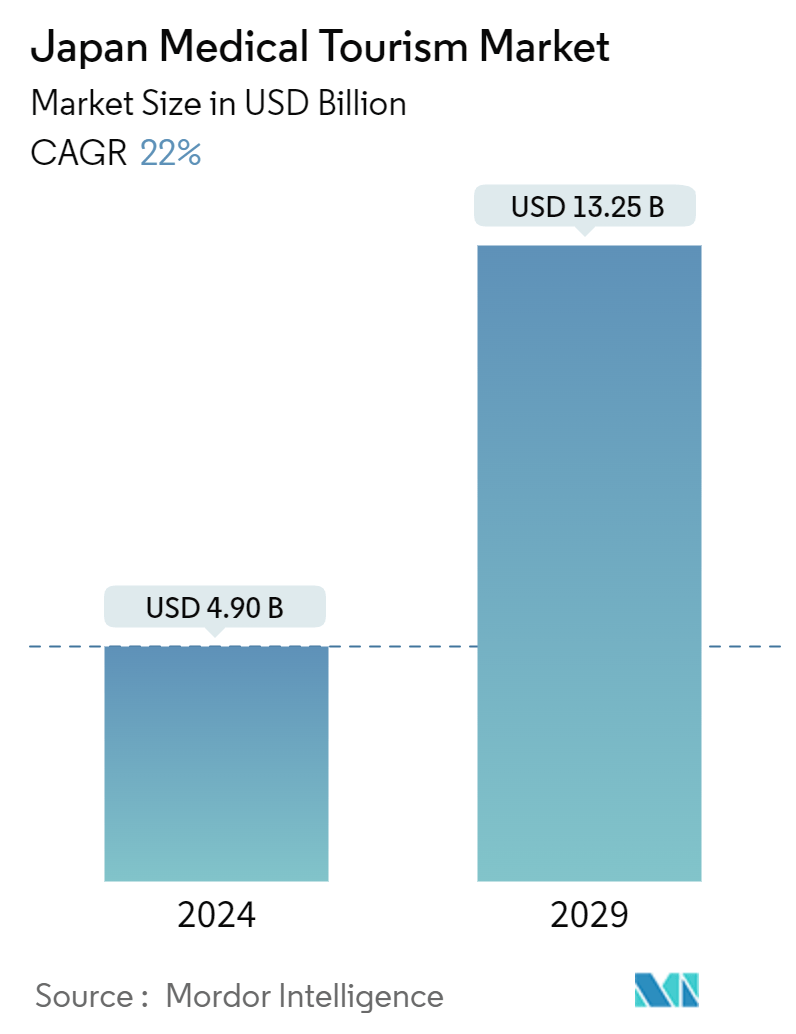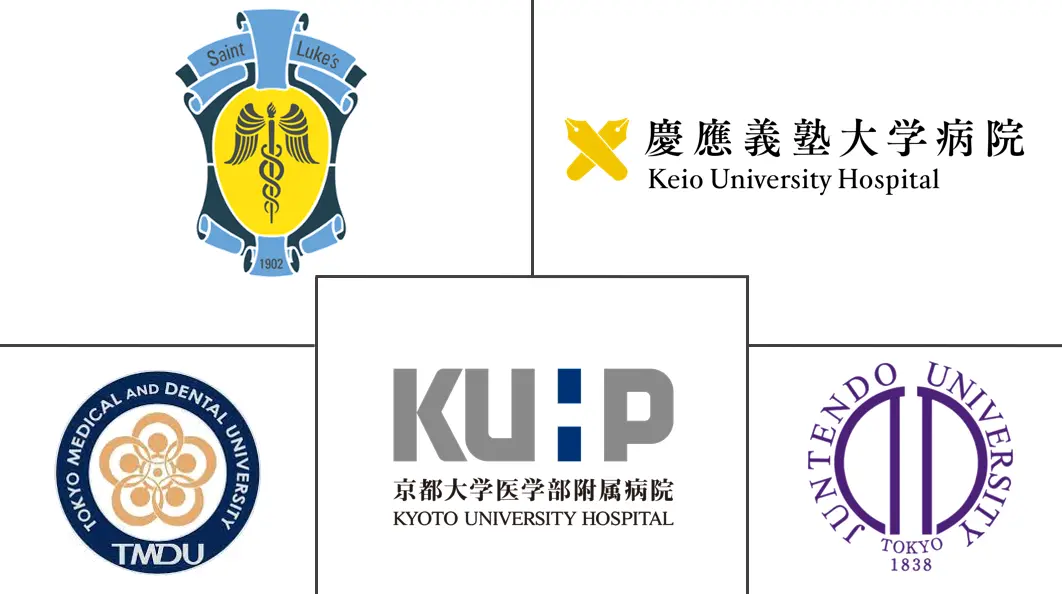Market Size of Japan Medical Tourism Industry

| Study Period | 2019 - 2029 |
| Base Year For Estimation | 2023 |
| Market Size (2024) | USD 4.90 Billion |
| Market Size (2029) | USD 13.25 Billion |
| CAGR (2024 - 2029) | 22.00 % |
| Market Concentration | Low |
Major Players
*Disclaimer: Major Players sorted in no particular order |
Japan Medical Tourism Market Analysis
The Japan Medical Tourism Market size is estimated at USD 4.90 billion in 2024, and is expected to reach USD 13.25 billion by 2029, growing at a CAGR of 22% during the forecast period (2024-2029).
The high prevalence of key disease conditions, including cardiovascular diseases, cancer, diabetes, and infectious diseases, coupled with the availability of advanced treatment options in Japan, is augmenting the growth of the market. For instance, according to the data updated by the National Cancer Registry in January 2024, there were around 1,033 thousand cancer cases in Japan as of 2023, of which 161 thousand were colon/rectum cases, 132 thousand were lung cancer cases, and 129 thousand were stomach cancer cases. This high prevalence of cancer is increasing the demand for advanced treatment options, which is projected to drive market growth during the forecast period.
Initiatives by the Japanese government to welcome tourists are addressing the lack of treatment facilities in lower-middle-income countries and attracting them to Japan for medical tourism, which is fueling the demand for medical tourism in Japan. For instance, according to an article published by LaingBuisson in June 2022, Japan offered limited package tours to triple-vaccinated travelers from the United States, Australia, Thailand, and Singapore to understand the broader resumption of tourism.
Additionally, rising technological advancements in healthcare infrastructure in Japan, along with advanced facilities offered by private players for tourists coming to Japan for treatment purposes, are also surging the adoption rate of this service. For instance, according to the data accessed from the Organization for Economic Cooperation and Development (OECD) in May 2024, Japan, on average, spends around USD 5,251 per capita on health every year, similar to the OECD average of USD 4,986, which is equal to 11.5% of GDP, compared to 9.2% on average in the OECD. As per the same source, there were around 12.1 practicing nurses compared to the OECD average of 9.2 and 12.6 hospital beds per 1,000 population, more than the OECD average of 4.3. This rising investment in healthcare is resulting in the introduction of advanced healthcare technology in Japan and leading to the increasing adoption of Japanese healthcare facilities by the global population.
Thus, owing to the factors such as the rising number of diseases and surging healthcare expenditure the market is anticipated to register a lucrative growth rate during the forecast period. However, post-surgical complications and difficulties in patient follow-ups are some of the factors hindering market growth.
Japan Medical Tourism Industry Segmentation
Medical tourism refers to the practice of traveling to another country to receive medical treatment or procedures. It involves individuals seeking healthcare services outside their home country, often due to various factors such as cost, quality, availability, or a combination of these.
The Japanese medical tourism market is segmented by treatment type and providers. By treatment type, the market is segmented into cardiovascular, oncology, neurology, orthopedics, cosmetics, and other treatment types. By service providers, the market is segmented into public and private. The report offers market sizes and forecasts in terms of value (USD) for all the above segments.
| By Treatment Type | |
| Cardiovascular | |
| Oncology | |
| Neurology | |
| Orthopaedics | |
| Cosmetic | |
| Other Treatment Types |
| By Service Provider | |
| Public | |
| Private |
Japan Medical Tourism Market Size Summary
The Japan medical tourism market is poised for significant expansion, driven by the country's advanced healthcare infrastructure and the high prevalence of diseases such as cancer, cardiovascular conditions, and neurological disorders. The availability of cutting-edge treatment options in Japan attracts international patients, particularly from lower-middle-income countries where such facilities are limited. Government initiatives to promote Japan as a medical tourism destination, along with the country's robust healthcare spending and technological advancements, further bolster market growth. Private service providers play a crucial role in facilitating medical tourism by offering comprehensive support services, making the process more accessible for foreign patients. The concentration of private hospitals in Japan, which offer advanced medical care, is a key factor contributing to the market's expansion.
The neurology segment is expected to hold a significant share of the market, driven by the increasing global prevalence of neurological conditions and the shortage of treatment facilities in other regions. Japan's aging population and the high incidence of dementia underscore the demand for advanced neurological treatments. The growing number of neurologists in Japan helps reduce wait times and enhances the country's appeal as a destination for neurological care. Key players in the market, such as St. Luke's International Hospital and Keio University Hospital, are instrumental in maintaining Japan's status as a leading medical tourism destination. Recent developments, including partnerships to enhance luxury medical tourism and the integration of wellness programs, further illustrate the dynamic nature of the Japanese medical tourism market.
Japan Medical Tourism Market Size - Table of Contents
-
1. MARKET DYNAMICS
-
1.1 Market Overview
-
1.2 Market Drivers
-
1.2.1 High Cost of Disease Treatment in Developed Countries
-
1.2.2 Presence of Advanced Technology in Japan Healthcare Facilities
-
-
1.3 Market Restraints
-
1.3.1 Difficulties in Patient Follow-ups and Post-Surgical Complications
-
-
1.4 Porter's Five Force Analysis
-
1.4.1 Threat of New Entrants
-
1.4.2 Bargaining Power of Buyers/Consumers
-
1.4.3 Bargaining Power of Suppliers
-
1.4.4 Threat of Substitute Products
-
1.4.5 Intensity of Competitive Rivalry
-
-
-
2. MARKET SEGMENTATION (Market Size by Value - USD)
-
2.1 By Treatment Type
-
2.1.1 Cardiovascular
-
2.1.2 Oncology
-
2.1.3 Neurology
-
2.1.4 Orthopaedics
-
2.1.5 Cosmetic
-
2.1.6 Other Treatment Types
-
-
2.2 By Service Provider
-
2.2.1 Public
-
2.2.2 Private
-
-
Japan Medical Tourism Market Size FAQs
How big is the Japan Medical Tourism Market?
The Japan Medical Tourism Market size is expected to reach USD 4.90 billion in 2024 and grow at a CAGR of 22% to reach USD 13.25 billion by 2029.
What is the current Japan Medical Tourism Market size?
In 2024, the Japan Medical Tourism Market size is expected to reach USD 4.90 billion.

